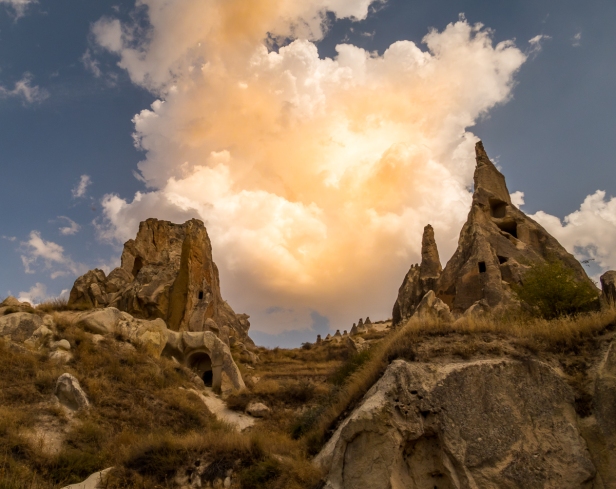
17-20 September 2015.
1. Strange and Spectacular Landscape: Cappadocia covers an area in central Turkey about 400 kilometres (250 m) from east to west and 250 kilometres (160 m) from north to south. The entire expanse is semi-arid with sparse rainfall. Each day we are there it is hot and dry. It feels like a harsh parched desert peppered with rock formations from another world.
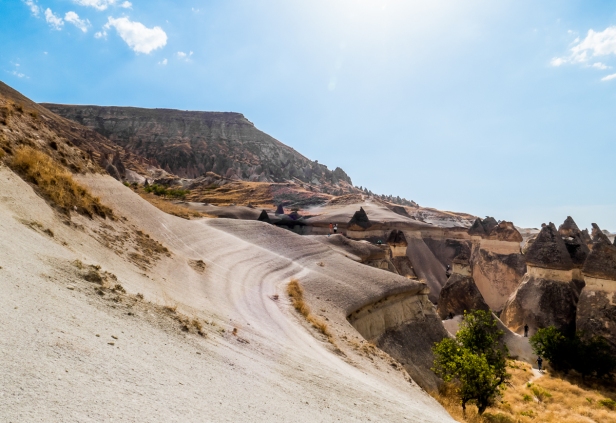
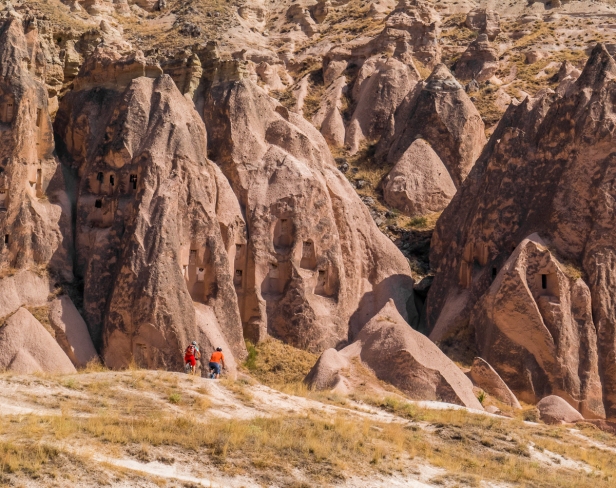
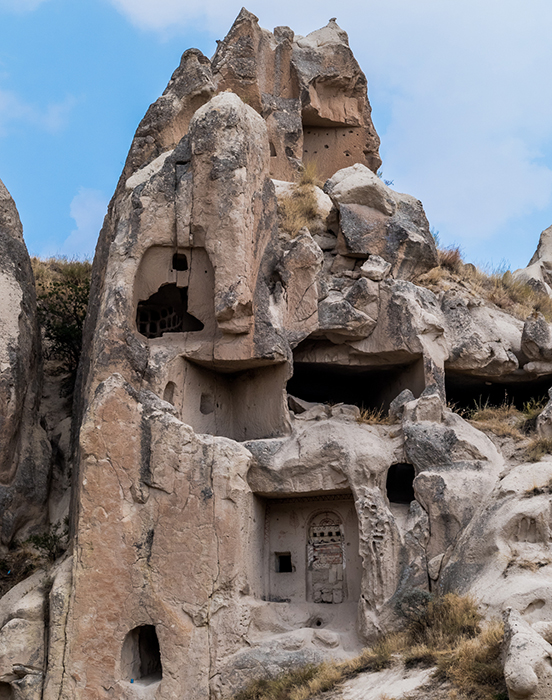

The pinnacles are affectionately called “fairy chimneys”. Travelling the area we discover that they are everywhere.

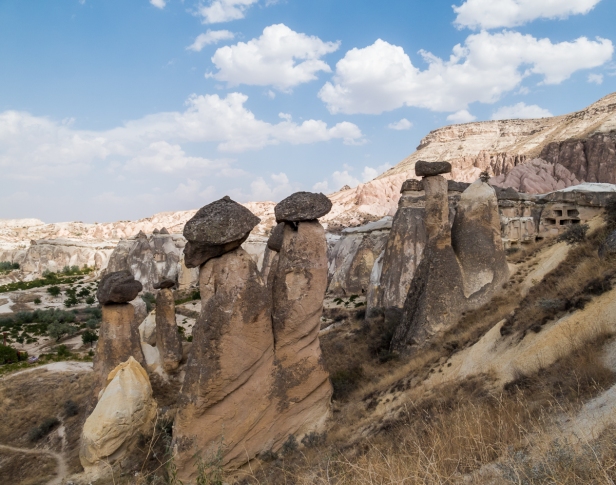
2. Pigeons: There are also pigeons everywhere. I’ve heard them described as rats with feathers. There are always pigeons, wherever we go. We take them for granted. We would have barely noticed them here in Cappadocia except that their feet are covered in feathers.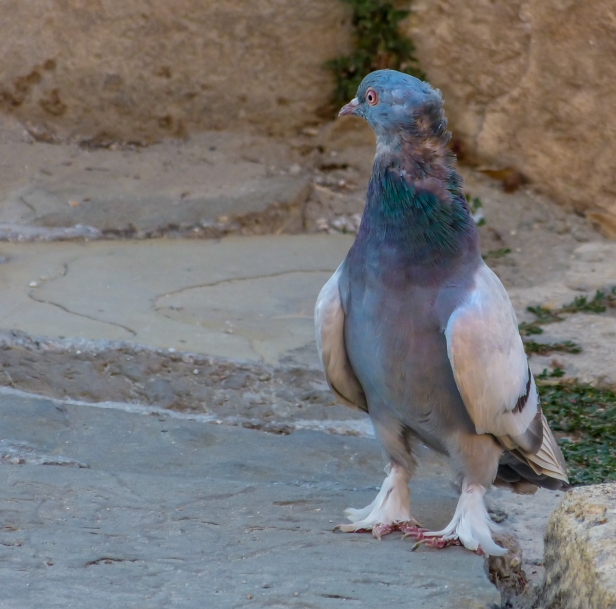
Then we learn of their special importance in this part of the world. Pigeons were farmed for feathers and food, and trained to carry messages. Most importantly their dung was used as manure. The soil in Cappadocia is very infertile. Hundreds of years ago it was discovered that pigeon dung makes great fertilizer. As a result the window and door entrances of many of the old churches and monasteries were walled up to create pigeon coops. Niches and small holes were carved in the walls for the birds. Through a small doorway, sealed with a wooden door, once a year, the dung was cleared out and used for fertilizer.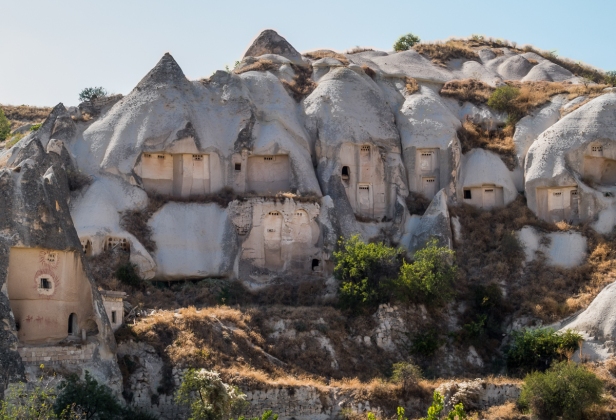

Cappadocia is known for its excellent apricots, and to this day some farmers use pigeon dung as fertilizer claiming it is the reason for the exceptional taste of their fruit. I eat local dried apricots with my breakfast every morning. They are really good.
3. Uchisar Castle: Just five kilometres from Goreme is Uchisar with its impressive castle that dominates the skyline. It’s a tall volcanic outcrop that’s visible for miles and which, unsurprisingly, was used by the Romans as a fortress. It’s riddled with rooms and tunnels and stairways, and it’s possible to climb to the top. Villagers used it for centuries as a place of refuge when there were warring factions on the plains below. We don’t climb up to the top. The view of it at sunset is rewarding enough.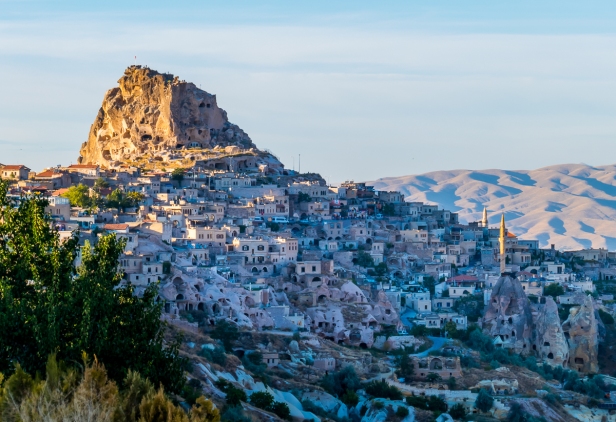
4. The Evil Eye: Everywhere we go there are blue discs for sale. They range in size from tiny, about five millimetres (1/4 of an inch) across, to ten centimetres (four inches). These talismans, known as nazars, are to protect against the evil eye: a curse cast by a malevolent glare. Many cultures throughout the world and throughout time, believe that bad luck will befall a person who has been given the evil eye, and Turkey is no exception. Nazars are found in houses and vehicles, and worn as beads. We were given tiny ones.
5. Byzantine Churches: Three young shepherd boys, taking refuge from stormy weather, are inside an abandoned cave church. The only religion they know is Islam and they have been taught that the depiction of any images in a sacred space is sinful. On the rock wall in front of them there are frescoes left from Christian times long before they were born. They are using the face of one of the Christian saints as target practice. Over and over they hurl pebbles at the face, seeing who can do the most damage. It’s fun. They’re out of the weather, their flocks are huddled out of the wind, and they get to while away the time practicing their aim. It’s a common occurrence in the cave churches of Cappadocia after they were abandoned in 1923 when the orthodox Christians were expelled from Turkey in a population exchange with Greece.
The Goreme Open Air Museum, is a vast collection of Byzantine churches, chapels and monasteries carved from the rock cones and chimneys dating from the tenth century. There are scores of refectories, each with it’s own church. It began as a Byzantine monastic settlement that housed about twenty monks. By the seventeenth century it had become an important place of pilgrimage. The medieval orthodox Christian monks carved into the soft rock creating homes and places of worship. Gradually more and more were created as Christians sought refuge here, and later came as pilgrims. The monks decorated the churches with frescoes.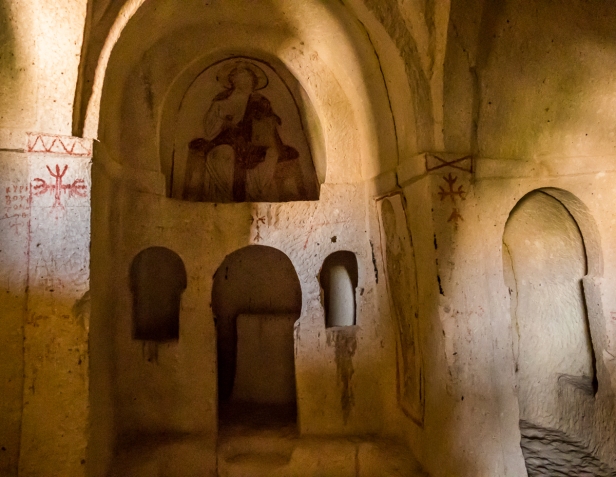
Weather, earthquakes, and shepherd boys like those mentioned above have damaged many of the cave churches, but the most beautiful still survives. The church known as Karanlık Kilise, the dark church, has very few windows, and it is this lack of light that helped preserve the magnificent frescoes, which have recently been restored to their original splendour.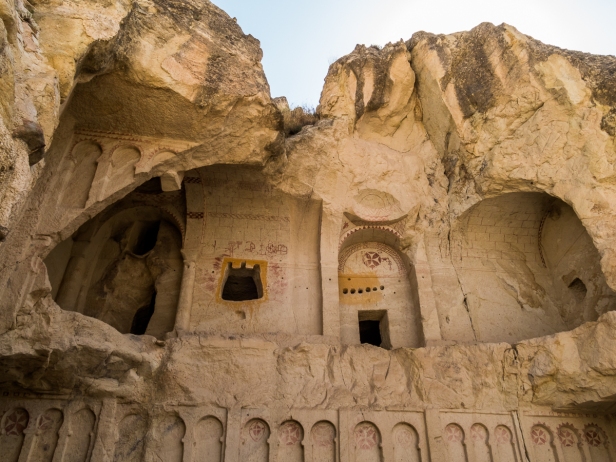
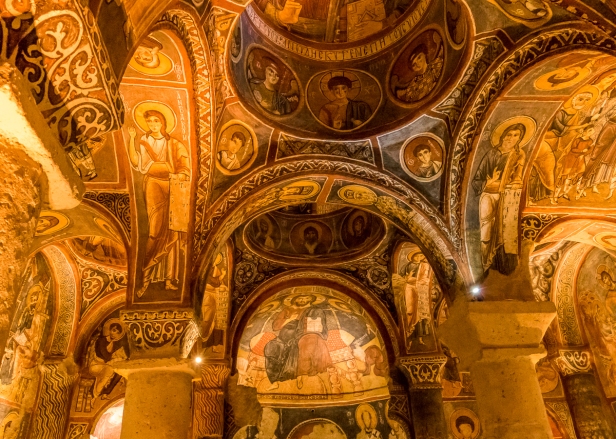
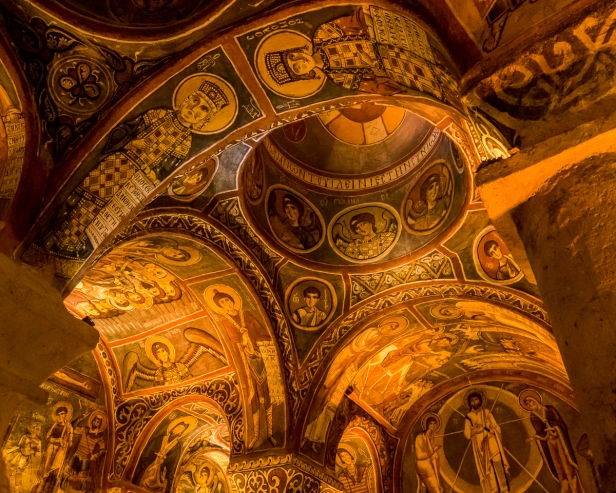
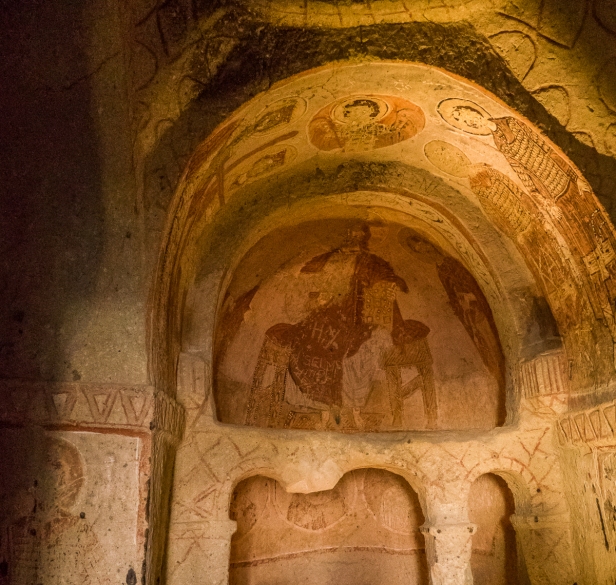
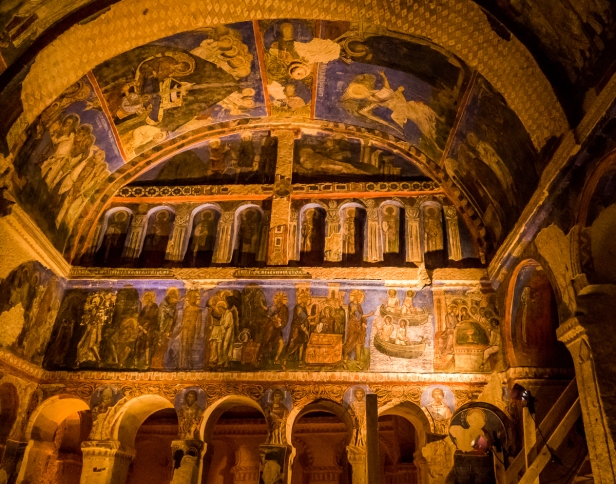
6. Hittite Wine Jugs: About 3600 years ago the Hittites established an empire in what is now Anatolia in central Turkey. They worshiped Ra, the sun god. To honour their god the Hittites designed their traditional wine jugs in the image of the sun, or a big O. The hole in the middle allows the jug to be carried on the shoulder for pouring. It also means that the server pouring wine for the king is forced to bow down as he pours. These beautifully handcrafted pieces are still made and used in Cappadocia today. Wine has always been important in Turkey. According to legend, after the flood when Noah’s ark came to rest on Mt Ararat one of the first things he did was plant a vineyard. Mount Ararat is very close to Armenia, Azerbaijan and Georgia. This part of the world is thought to be the place of origin of the wild vine species vitis vinifera sylvestris, from which all domestic vines are derived.
We are taken to a large outlet for traditional Turkish pottery where a master potter demonstrates the process of making the Hittite wine jug. The pot is made in pieces – top, body, bottom, and circle, and then the pieces are joined together.
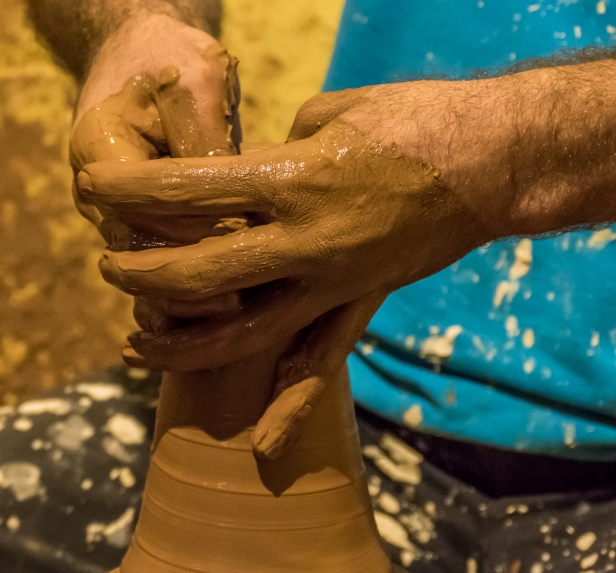
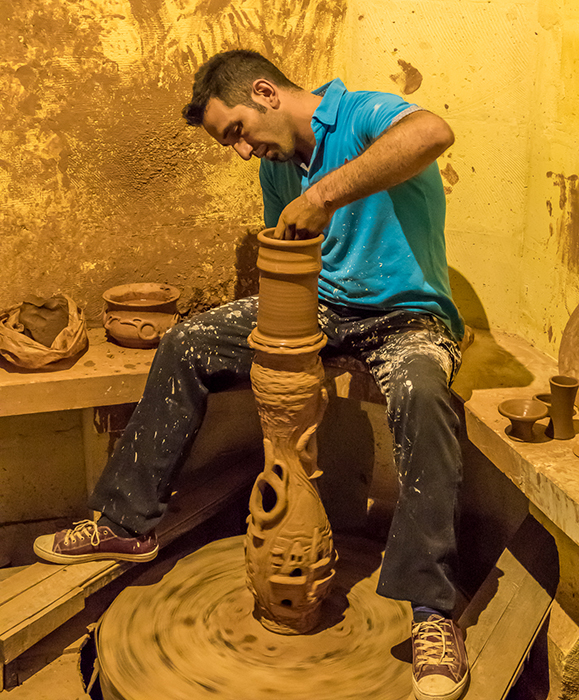
Making the circle: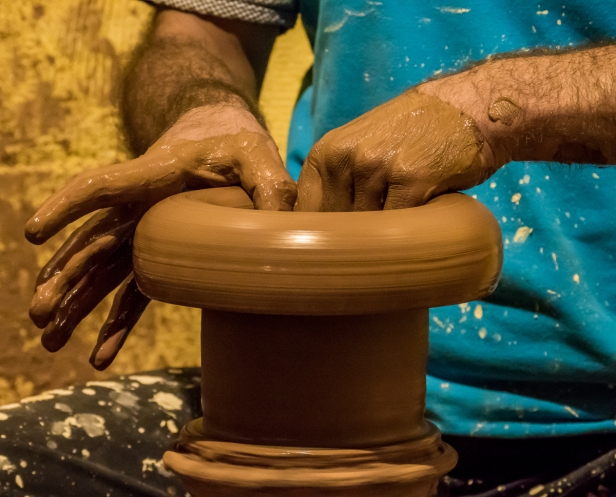
After completing the jug,
he slices through the soft clay with a wire so we can see the inside.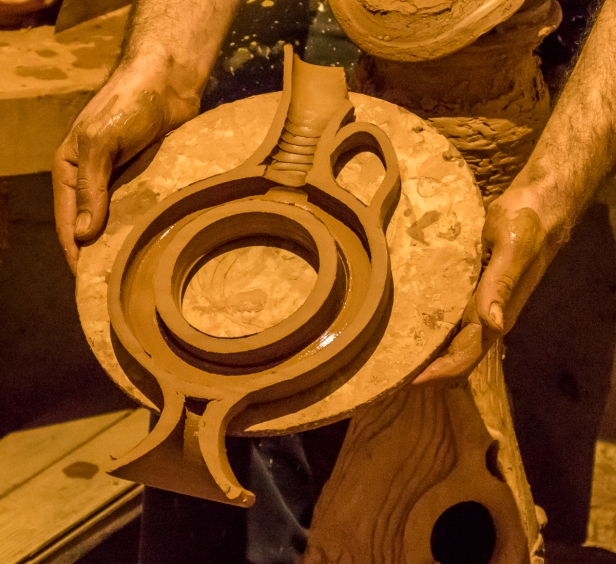
After firing the jugs are hand painted in traditional designs.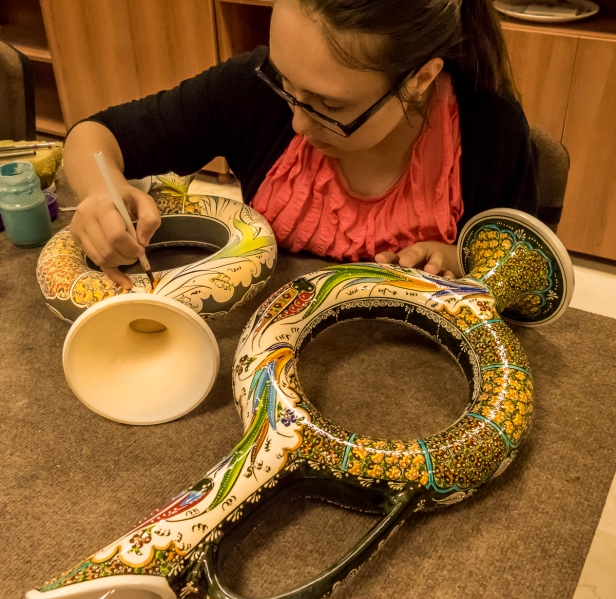
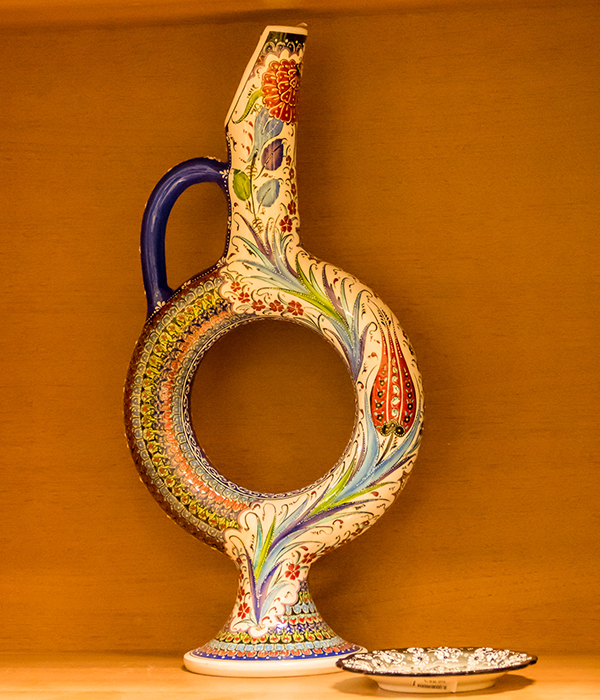
7. Turkish Carpets: Marco Polo reported that the best and finest carpets were produced in Turkey. It could probably be argued that they still are. They are made with silk, wool or cotton, or a mixture. Rugs are hand woven on a loom: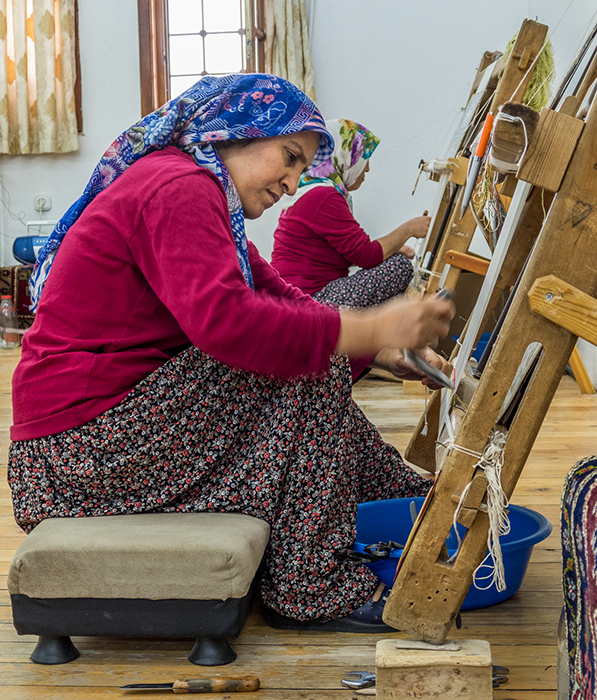
In the showroom rug after rug after rug is spread on the floor before us. They come in all sizes, and every colour.
From Goreme we catch the chicken bus without the chickens to Kaiseri Airport and fly to Istanbul.
Next couple of posts: All about Istanbul. The sights and sounds of the markets and bazaars. What women wear. A couple of beautiful mosques. The waterfront by day, and by night. Agia Sofia. Nargile pipes. A brilliant dance performance. Public displays of affection – or not. And much more.
Goreme Open Air Museum
All words and images by Alison Louise Armstrong unless otherwise noted
© Alison Louise Armstrong and Adventures in Wonderland – a pilgrimage of the heart, 2010-2016.

Cappadocia looks like another planet. Have not been there yet. Though pigeons are a familiar sight, we have plenty of them in Kraków. The problem is we don’t use them for anything, so they just fly / walk around, flying rats they are!
LikeLiked by 1 person
Cappadocia is wonderful. Get there if you can, it’s a really special place.
This is the first time I’ve come across the use of pigeons for fertilizer, though they’ve been used in many countries as messengers for years. And probably for food too.
Alison
LikeLiked by 1 person
Astonishingly beautiful photos, Alison. You brought Cappadocia to my desk top. And those pots!
LikeLiked by 1 person
Thanks so much Tish. Cappadocia was amazing, and those pots are fabulous! Such beautiful designs and colours. It was fascinating to see how they’re made.
Alison
LikeLiked by 1 person
Another world is right, Alison! Cappadocia is magical with its fairy chimneys and Uchisar Castle and the Gorem Open Air Museum looks especially fascinating. While we don’t collect many souvenirs I’d really love one of the Hittite wine jugs. Your pictures on how they are made were very interesting and I love the hand painted designs too. Anita
LikeLiked by 1 person
Cappadocia was everything we’d hoped for – amazing place. The Hittite jugs were an unexpected extra. I also love the designs. We don’t collect things either, but if we had a home I’d sure like one of them to put in it. They’re so beautiful.
Alison
LikeLike
Oh, I am sooo jealous. I never got to Cappadocia. And it was the one place I knew I wanted to see in Turkey. This is a post I really love—well, any post with pigeon poop in it gets my vote. And I’m loving your photos as usual. I like the softness of them. I don’t know how you do that. For some reason, I really like the photo of the carpets, the movement. It brings back memories maybe.
LikeLiked by 1 person
Thanks BF. I hope you get to Cappadocia – definitely worth it. Of course I had to mention the pigeon poop! It was such an important part of survival in the area. And they were everywhere. And they have feathers on their feet – I’ve never seen that before! I don’t know how I do the softness. It just happens, maybe something to do with dull light rather than harsh sunlight. The carpet experience was amazing. I should have written more about that. They must have brought out hundreds of carpets, one after the other, throwing them down on the floor, so quickly you hardly had a chance to look at them. They were just about flying through the air.
Alison
LikeLike
Bucket lists and expectations…hmmmm. I bought a carpet in Istanbul one time. I did not mean to buy one, didn’t want one. But I walked into this one shop, and saw this carpet hanging on the wall and knew I would buy it. And did.
LikeLiked by 1 person
What a splendid post!!! Looks beautiful from the description and the pictures and definitely worth a visit 🙂
LikeLiked by 1 person
Thanks so much Aishwarya. It really is a beautiful, and fascinating place, and most definitely worth a visit.
Every time I see your name I think of Aishwarya Rai. 🙂
Alison
LikeLiked by 1 person
Haha yes she has made the name popular now, hasn’t she 🙂
LikeLiked by 1 person
Cracker post and beautiful photographs!
LikeLiked by 1 person
Thank you so much. It’s an amazing place.
Alison
LikeLiked by 1 person
Beautiful post and photos! What an amazing place!
LikeLiked by 1 person
Thanks Pelly. Yes – amazing!
Alison
LikeLiked by 1 person
Surreal and magical places, indeed. Great photos!
LikeLiked by 1 person
Thanks so much Christie. We were completely enchanted – the landscape is so unusual. It often felt surreal.
Alison
LikeLiked by 1 person
As always breathtaking photos and fascinating information.
LikeLiked by 1 person
Thanks Eileen. Cappadocia exceeded our expectations. Not enough superlatives!
Alison
LikeLike
Cappadocia is absolutely magical, Alison. And your photos have captured it beautifully. Of all of your blogs that I have enjoyed (which is all of them), this may very well be my favorite. Throwing the rugs on the floor: Peggy and I went through the experience in Turkey as well. It amazed us how many they threw out, and how quickly. –Curt
LikeLiked by 1 person
Thanks Curt. Your favourite? Wow. Thank you. This post was actually a bit of a struggle for me, but it finally came together. Yes Cappadocia is absolutely magical. Did you get there. I can’t imagine anyone would go to Turkey and miss it. The rug dance! I should have written more about it – the way they threw the carpets, so many of them so quickly. It was a wonderful show to watch even if we weren’t buying.
Alison
LikeLike
There was only time for one stop in Turkey, sigh. Next time. 🙂 And the rug salesmen are absolute masters. Peggy’s brother bought one, and I had to almost put a blindfold on Peggy! –Curt
LikeLiked by 1 person
beautiful & exotic
this nature & human
expression does
to me 🙂
LikeLiked by 1 person
Oh yes, so much beauty
So much joy
in this exotic place.
Thank you for coming
along on the journey.
Alison ❤
LikeLike
I feel like I am right there with you. I love the way you took us through the pot-making step by step. So lovely!
LikeLiked by 1 person
Thanks so much Marsha. I’m glad you felt like you were there. There was so much there to explore and experience. And the pot making! That was really fascinating. I had no idea. I guess I hadn’t even really thought about it and then to see it demonstrated was really interesting.
Alison
LikeLiked by 1 person
Lovely pics! Thanks for sharing.
LikeLiked by 1 person
Thanks scribbler, glad you enjoyed it. What a fabulous place it is!
Alison
LikeLiked by 1 person
The Hittite wine jugs are amazing. I sent the info to my potter daughter who lives on a small island near Vancouver Island.
LikeLiked by 1 person
Aren’t they incredible. I’d seen them but not even thought about their purpose or history, even less about how they were made. It was fascinating to see the demonstration. And they’re so beautiful!
Alison
LikeLike
Hi Alison, I thoroughly enjoyed reading this post and seeing those wonderful photos! You’ve done so well. A wonderful experience for me to read this, though a much greater one for you to have lived it. I loved the pigeon story, why not utilise the manure for fertilising? Make sense.
LikeLiked by 1 person
Thanks so much Sue and Dave. I’m glad you enjoyed a little vicarious trip to Cappadocia. Do you think you’ll get there one day? I highly recommend it – fascinating place. I too enjoyed the pigeon story. Most of the time I take them very much for granted, but this gave me a whole new perspective on them.
Alison
LikeLiked by 1 person
We have so much unplanned for our future travels right now so anything is possible, we’d love to visit Cappodocia and have a rule to never rule anything out!
LikeLiked by 1 person
That’s a very good rule! 🙂
LikeLike
Do you see eyes and faces in some of the cave dwellings? They jumped out at me from your photos! I love that first picture, with the sunny ball of clouds held carefully in the pincers of the rocks so it does not burst any more and spill its yolky innards! Like Badfish and others, I’m also drawn to the movement of the rug as the sellers throw them in their piles … I bought two rugs in Turkey and still find them uniquely beautiful. Lovely post (as always!).
LikeLiked by 1 person
I sure see the faces in Karanlik Kalisi. I think it’s one of the very few that wasn’t defaced, probably because it’s dark inside. I love your description of the first photo! Very evocative. I was pleased with that photo, but full disclosure, I did up the saturation of the cloud a bit. I love playing in Lightroom and Photoshop and I am unashamedly not a purist 🙂
The rug sellers were amazing – it was like a choreographed dance! I love the colours and designs of Turkish rugs. There were so many I was drawn to.
Alison
LikeLiked by 1 person
Fascinating and mysterious place! I see stone people everywhere! It looks like Star Wars in some places!
LikeLiked by 1 person
It’s an amazing place. I’m so glad we went there, and that we had a few days so didn’t feel too rushed. I have a feeling some of star wars may have been filmed there.
Alison
LikeLiked by 1 person
These are things most people least expect from Cappadocia. It’s always images of the fairy chimneys and the balloon ride that conjure up in people’s minds about this part of Turkey. Thanks for introducing these jewels, Alison. Now I have so many things to explore when I go to Cappadocia one day. I wonder if I should also get myself a Hittite jug, it’s so beautiful!
LikeLiked by 1 person
There was so much to see and do in Cappadocia, and so much more than the balloon ride and the fairy chimneys. I didn’t even cover it all in the two posts that I’ve done about it. We went for a long hike down a lush valley, and there are many many churches and monasteries to explore in the Goreme Open Air Museum. It’s a really fascinating place with a rich history. I hope you get there one day. And get yourself a hittite jug. I agree they’re very beautiful.
Alison
LikeLike
Absolutely gorgeous photos. That first one with the illuminated cloud is breathtaking. I love the pottery ones too. We still have a nazar from Turkey at our front entrance. It’s a little worse for wear but seems to be doing the job (touch wood)! We also have 2 rugs, negotiated for over many cups of alma chai as I recall. They’ve held out well. Lovely memories. Thanks!
LikeLiked by 1 person
Thanks Caroline. The whole place is sooo photogenic. And the pottery demonstration was fascinating. We lost our nazars. They were tiny and they got lost in the endless shuffle. I love Turkish carpets. It must be wonderful to have them in your home. The colours are so rich and beautiful.
Alison
LikeLike
Fantastic! You are definitely convincing me to go to Turkey, despite my unfortunate experience flying through Istanbul. Cappadocia, of course, makes one think of Dr. Seuss, but it also reminds me of Oblio and the Land of Point, a children’s musical album by Harry Nilsson.
LikeLiked by 1 person
Thanks Jane. Yes – go to Turkey! It’s fabulous! Cappadocia is surreal and endlessly fascinating. I’m familiar (somewhat) with Harry Nilsson, but not with his children’s musical. What happened in Istanbul?
Alison
LikeLike
It’s a delightful story. Look it up sometime on YouTube.
Here’s what happened in Istanbul https://plainsweetjane.wordpress.com//?s=istanbul&search=Go
on the very first day of my year-long trip. It was the ONLY bad thing that happened to me that whole year! My son said it was my hazing.
LikeLiked by 1 person
I just re-read the Istanbul post. I’d forgotten about that harrowing start to your travels. But it seems it all came good after that.
A.
LikeLike
Beautiful, mysterious, magical
LikeLiked by 1 person
Thank you. Yes it is!
Alison
LikeLike
Oh Alison I do adore this post! I had to share in my fb page! Such gorgeous photos and excellent facts on such an amazing place that I have to see! Love it!
LikeLiked by 1 person
Thanks so much Nicole. I hope you get to go there one day. It’s really special and definitely worth visiting.
Alison
LikeLiked by 1 person
oh the golds and yellows I love and another cool place…nice cloud on the opening image…like I enter another world Alison ~ lovely post! ❤️
LikeLiked by 1 person
Thanks Hedy. It was beautiful there, truly magical in so many ways. Yes, a very cool place.
Alison
LikeLiked by 1 person
And you’ve shared it so beautifully Alison…happy days ~smiles
LikeLiked by 1 person
Alison, you remind me with every beautiful post how much I enjoyed Cappadocia. Your featured image is gorgeous, as is the wine jug. We broke our no shopping rule for a small Hitiite plate from Avanos!
LikeLiked by 1 person
Thank you Madhu. We enjoyed it very much too – such a special place. I loved those wine jugs! and probably would have bought something too if we’d had anywhere to put it.
Alison
LikeLike
Just superb, what an amazing place and your photos, along with your narrative, bring it to life. Thank goodness those shepherd boys left at least one church and all the beautiful frescos. As for the jugs I think I would really like to take one home, the shape and colours are stunning and I love how your photos bring the creative process of the potter and painter to life. Another post to savour Alison.
LikeLiked by 1 person
Thanks pommepal. Cappadocia’s a really amazing place and I’nm so glad we went there. I think nobody ever went into Karanlik Kilise because it was so dark in there, so the frescoes were preserved – thank goodness. They’re very beautiful. I love the jugs – the designs and colours are just gorgeous. It was fascinating to see how they were made.
Alison
LikeLiked by 1 person
Intoxicating. Love the cave homes and churches. I can certainly agree with the assessment of pigeons as rats with wings. They are beautiful until they are over populated. lovely pics.
LikeLiked by 1 person
Thanks Robyn. The cave homes and churches are definitely part of the fascination of Cappadocia. The whole are is riddled with troglodyte dwellings that are up to thousands of years old. I don’t mind pigeons. I found the ones in Cappadocia interesting because of the feathers on their feet – I’d never seen that before. And then I learned how they used them for fertilizer and thought that was pretty cool.
Alison
LikeLike
I have to go to Cappadocia.The photos are stunning. I love the photo of the rugs being flapped out on the pile… brings back memories
LikeLiked by 1 person
Thanks so much Louise. Cappadocia is amazing! I hope you get there one day. Those guys with the rugs were quite amazing. It was like a dance. They brought out dozens of them, and flipped them out on the floor in front of us, layer upon layer, every size, shape, colour. I wanted to buy several of them if I had a home to put them in.
Alison
LikeLiked by 1 person
It looks magical through your eyes, Alison. I had no idea. I have a tiny silk Turkish carpet but that wonderful pottery was calling out to me too. 🙂 You’ve changed bases in Mexico?
LikeLiked by 1 person
Thanks Jo. It really is magical, a very unusual and surreal landscape. And the pottery is beautiful. I found it fascinating to see how they made the jugs.
We’ve moved to La Manzanilla for our final two months in Mexico. I’m so glad. We’re back in a little slice of heaven again. We were here for four months three years ago and I’ve never forgotten it.
Alison
LikeLike
I’ve seen photos and I can imagine. 🙂 Enjoy!
LikeLiked by 1 person
Interesting that you were able to photograph inside the churches. We were here in 2010 and were quite aggressively told not to photograph. I am not sure to what purpose, as we weren’t interested in the postcards I think they were trying to protect. You take wonderful photographs. I love the one of the rug with the movement. I asked a question of you a few posts back about what you travel with. It was a serious question. I would love to know what you take with you and what you leave behind, and also what camera gear you use. Its obviously enough as your pictures are lovely.
LikeLiked by 1 person
Thank you so much Helen. I am a bit in awe of your photography so your compliment means a lot to me. As far as I remember I took the photos in the churches when no one was looking – a couple of quick sneaky shots without flash. I think they don’t like you to photograph as flashes can cause deterioration of the frescoes and it’s virtually impossible to get everyone to turn off their flashes so they just ban all photography. I remember a guard in Versailles a few years ago getting very upset with me taking pictures with flash. I would have turned it off but I was so unfamiliar with the camera I didn’t know how!
I read my reply to your previous question and am astonished to find I didn’t actually tell you the make and model of my camera. It’s a Panasonic FZ1000. It has built-in flash and 24-400 Leica zoom lens (2.8 to 4.00), and a 1″ sensor. I look at the photographs you put on FB and long for a camera with a bigger sensor and better lens so I can get that kind of sharpness, but at the same time I’m always aware of the size and weight of what I carry around. I know when Julie travels she takes a whole carry-on size case of camera/electronic equipment apart from everything else. I travel with a college-book-bag size backpack and a carry-on size case, and my camera, total. I like the Panasonic because of the lens and the flip out LCD screen which I use to take photos hiding behind Don, and I like that it’s just one simple piece, but it’s not so good in low light – need a lot of luminance adjustment in Lightroom.
Did you want more details about what we carry? Here’s the link again to the post I did with a list of what we carry but it doesn’t list any clothing.
We no longer carry mosquito nets, having found they’re always provided when necessary, and we take antibacterial gel instead of hand wipes.
Hope this answers your questions. If not – ask away! I’m happy to answer anything you want to know.
Alison
LikeLike
Thanks Alison for the long and detailed reply. I was more curious about the camera gear than anything. If you think Julie carries a lot of gear, you should see us! We shoot a lot of wildlife so we each have a couple of long lenses that take up a lot of weight and space. We also each have a laptop (albeit a small notebook size) and portable hard drives to back up our images. In the suitcases we also each have a tripod and accessories for cleaning etc. So Julie’s gear is lightweight compared with ours! I really loved my Canon G 12 with the flip screen and in-built zoom lens but unfortunately the zoom gets stuck sometimes. The best thing about it was that it could shoot in raw so I had a lot more room to correct images in post production. But as you say, if you want to go compact then you have to sacrifice some quality. We like to print our images and enter competitions so we like to have the quality but if our primary goal was to shoot images for electronic media only then what you have is perfectly satisfactory and you do get some lovely results.
LikeLiked by 1 person
My Panasonic shoots in raw which is great, but now you’ve got me interested in the Canon G 12. There are new cameras coming on the market soon with mega mega pixels so I’m biding my time before I upgrade.
Even just for electronic photos I’d like better quality, sharper images, less noise in low light, but I’m still not willing to carry around the gear to get it. After nearly 12 months and some PS and LR lessons from Julie and Suzanne I feel like I’m starting to get the best from the camera I have. But I’ll never be a photographer. It’s not my passion – not the way it is for you and Julie and Suzanne.
A.
LikeLiked by 1 person
I love this post! We were in Turkey a year ago but never made it to these parts and now I see we will just have to go back! The photos are gorgeous, especially of the pinnacles. The evil eye blue glass is found in many Mediterranean places and in some just the color blue has remained as a “safety feature”….
LikeLiked by 1 person
Thanks Peta. Oh yes, you must go back – Cappadocia is amazing! Apparently blue is the most popular colour worldwide which is something I didn’t know until I did a little research about the blue Mediterranean.
Alison
LikeLike
Wow, the potter and the wine jugs are magnificent! I can’t believe he cut one in half. How long did it take him to make a jug? And that first photo… breathtaking! Great post!
LikeLiked by 1 person
Thanks so much Kelly. Making the jug took only about twenty minutes or so. He was very skilled and very efficient. It was amazing to see how the whole thing was constructed, and then to see it cut in half. I never would have thought!
The Cappodocia landscape is endlessly fascinating. I took thousands of photos of course. Everywhere I looked there was another arresting vista. I imagine it was the same for you. It’s so different from anywhere else I’ve seen.
Alison
LikeLiked by 1 person
Cappadocia is one of my favorite places. There is such a variety of things to see and those landscapes are awesome. I really liked the food too.
We met a lot of really great people there. Turks to me are not openly smiley and friendly, but as soon as you start talking to them they light up and are super friendly.
What was the mood there with the war in Syria so near?
LikeLiked by 1 person
Yes, Cappadocia is one of my favourite places too. We generally found Turks to be friendly but not overly so. They sure didn’t want us to find the hiking trails there. On the other hand on one occasion a man spontaneously walked up to us and invited us to his bakery for tea and treats, and on another one of the tourist police stopped to chat. We deliberately stayed away from eastern Turkey – too close to Syria and all the troubles there. It didn’t seem to impinge on western Turkey at all except perhaps there were less tourists than usual though not as extreme as in Egypt where the tourism industry has taken a huge hit. Syria seemed very distant.
Alison
LikeLike
I think I’ve met the same master potter. Skillfully indeed. The vase is also beautiful! But too big and expensive 🙂 Splendid photos of the cave churches, Alison. Photography is not allowed anymore. I think they could just ban the use of Flash.
LikeLiked by 1 person
Thanks so much Len. I don’t think I even used flash, but still, it would be better if they just banned flash and not photography entirely.
I agree – those vases are so beautiful!
Alison
LikeLiked by 1 person